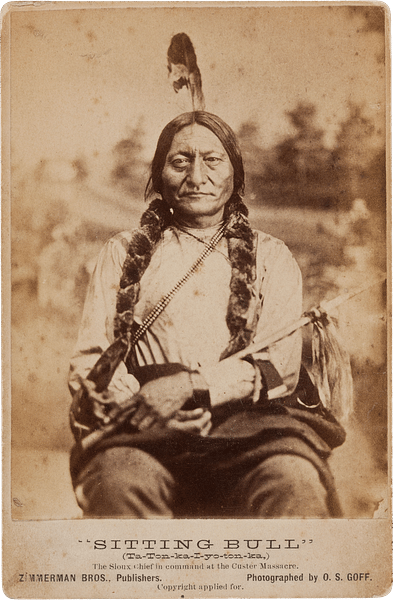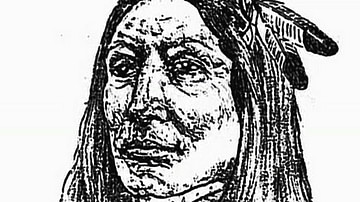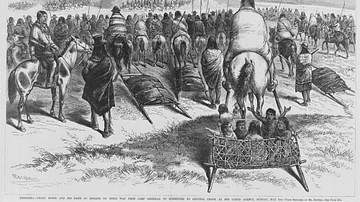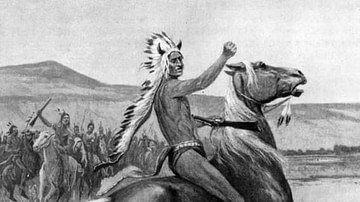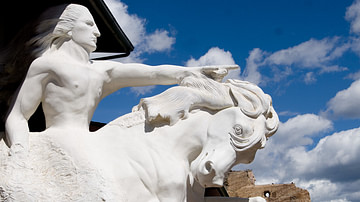
The Great Sioux War (also given as the Black Hills War, 1876-1877) was a military conflict between the allied forces of the Lakota Sioux/Northern Cheyenne and the US government over the territory of the Black Hills and, more widely, US policies of westward expansion and the appropriation of Native American lands.
The Fort Laramie Treaty of 1868 had established the Great Sioux Reservation, including the Black Hills, and promised this land to the Sioux in perpetuity. When gold was discovered in the Black Hills in 1874, the treaty was ignored by the US government, leading to the Black Hills Gold Rush of 1876. The Sioux, Northern Cheyenne, and Arapaho responded with armed resistance in raids on wagon trains, skirmishes, and five major battles fought between March 1876 and January 1877:
- Battle of Powder River (Reynolds Battle) – 17 March 1876
- Battle of the Rosebud (Battle Where the Girl Saved Her Brother) – 17 June 1876
- Battle of the Little Bighorn (Battle of the Greasy Grass) – 25-26 June 1876
- Battle of Slim Buttes – 9-10 September 1876
- Battle of Wolf Mountain (Battle of Belly Butte) – 8 January 1877
In between these, were so-called minor engagements with casualties on both sides but, after June 1876, greater losses for the Sioux and Cheyenne. The final armed conflict of the Great Sioux War was the Battle of Muddy Creek (the Lame Deer Fight, 7-8 May 1877), by which time the Sioux war chief Crazy Horse (l. c. 1840-1877) had already surrendered and the chief Sitting Bull (l. c. 1837-1890) and Sioux war chief Gall (l.c. 1840-1894) and others had fled to the region of modern-day Canada. Although the war was over by May 1877, ending in a victory for the US military, some bands of Sioux and Cheyenne continued to struggle against reservation life until the Wounded Knee Massacre of 29 December 1890 broke their resistance.
Background
Although the first armed conflict between the Plains Indians and Euro-Americans was in 1823, problems between the Sioux and the US military began on 19 August 1854 with the Grattan Fight (Grattan Massacre), when 2nd Lieutenant John L. Grattan led his command of 30 soldiers to the camp of Chief Conquering Bear (l. c. 1800-1854) to demand the surrender of a man they claimed had stolen a cow from a Mormon wagon train.
Conquering Bear refused to surrender anyone, offering compensation instead, and, as the negotiations broke down, Grattan's men fired on the Sioux, mortally wounding Conquering Bear, and the Sioux warriors retaliated, killing Grattan and all of his command. The US military responded with campaigns against the Sioux in the First Sioux War of 1854-1856, which also included actions against their allies, the Cheyenne and Arapaho.
Tensions escalated after the opening of the Bozeman Trail in 1863, the establishment of forts to protect white settlers using the trail, and the Sand Creek Massacre of 29 November 1864. Red Cloud's War (1866-1868) was launched in response to the construction of these forts and the policies of the US government, concluding with the Fort Laramie Treaty of 1868, which established the Great Sioux Reservation (modern-day South Dakota and parts of North Dakota and Nebraska), including the Black Hills – a site sacred to the Sioux – which was promised to them for "as long as the grass should grow and the rivers flow."

When Lt. Colonel George Armstrong Custer (l. 1839-1876) discovered gold in the Black Hills in 1874, the Fort Laramie treaty was broken as over 15,000 white settlers and miners streamed into the region during the Black Hills Gold Rush of 1876. The US government offered to purchase the Black Hills, but the Sioux would not sell. More settlers arrived, the government ignored Sioux demands that the 1868 treaty be honored, and the Great Sioux War began in March of that year, with the Reynolds campaign on the Powder River.
Battle of Powder River
Hostilities began when Colonel Joseph J. Reynolds (l. 1822-1899) led an attack against the camp of Northern Cheyenne and Oglala Lakota Sioux on the Powder River. In November 1875, President Ulysses S. Grant (served 1869-1877) ordered all Sioux to move onto the reservation by 31 January 1876 or be regarded as "hostiles" and subject to military force. When the Sioux ignored this ultimatum, General George R. Crook (l. 1828-1890) and General Alfred H. Terry (l. 1827-1890) were ordered to move against them in February 1876.
Reynolds, under Crook's command, moved against the Cheyenne-Sioux camp on the morning of 17 March, killing mostly women and children and coming under heavy fire from warriors who had positioned themselves on the high bluffs. Reynolds had been instructed to take whatever goods the army needed (as supplies were scarce) but, instead, set the village on fire, destroying buffalo robes, weapons, and food supplies. He also failed to post pickets around the approximately 500 horses captured, and these were retaken by the Cheyenne the next morning.
The engagement failed in all its objectives and only succeeded in driving the Northern Cheyenne to seek food and shelter from the camp of Crazy Horse to the north, creating a tighter bond between the Sioux and Cheyenne. The Battle of the Powder River, in fact, set the stage for the next two major battles in that Crazy Horse and the Cheyenne later joined Sitting Bull on the Little Bighorn River in one large encampment. As this first battle was primarily between the Cheyenne and the US military, and the Cheyenne were involved in all the following engagements, some scholars have suggested "Great Cheyenne War" instead of "Great Sioux War" as the more accurate term for the conflict.
Battle of the Rosebud
Over the next few months, the US military followed the Cheyenne-Sioux camps, finally skirmishing with the Cheyenne at the Battle of the Tongue River (Battle of Prairie Dog Creek) on 9 June. Crook then moved on toward Rosebud Creek, where he was met by the Shoshone war chief Washakie (l. c. 1810-1900) and the Crow chief Plenty Coups (l. c. 1848-1932), who had offered an alliance against the Cheyenne-Sioux.
On 17 June, Crook had given the order for his men to rest, and the Shoshone and Crow scouts took up guard duty on the overhead bluffs, when the soldiers heard the sounds of gunfire and then shouts warning of the approach of a large band of Sioux (led by Crazy Horse and supported by Sioux Chief Two Strike, l.c. 1831-1915). The warning by the Crow scouts gave Crook time to fortify his defensive position, and so he was able to repel Crazy Horse's assaults.
This engagement, like Powder River, was a victory for the Arapaho-Cheyenne-Sioux forces. Although Crook maintained he was the victor, his command would most likely have been wiped out if not for the intervention of the Crow and Shoshone, and, further, he retreated from the field, leaving it to the Sioux. The Cheyenne name for the engagement – Battle Where the Girl Saved Her Brother – comes from the moment when the Cheyenne warrior Comes-in-Sight was rescued by his sister, Buffalo Calf Road Woman, when his horse was shot out from under him.

Washakie and Plenty Coups had had enough fighting for a while and left Crook at his camp on Goose Creek. The Sioux forces claimed the field and then returned to the large encampment of Sitting Bull on the river known as the Greasy Grass or the Little Bighorn. At the Sun Dance ceremony in early June, Sitting Bull had received a vision of soldiers falling dead from the sky, prophesying a great Sioux victory, and, since this did not seem to refer to the Battle of the Rosebud, it was understood to foretell a battle yet to come.
Battle of the Little Bighorn
That engagement would be the Battle of the Little Bighorn of 25-26 June 1876. Lt. Col. George A. Custer, Major Marcus Reno (l. 1834-1889), Captain Frederick Benteen (l. 1834-1898), Captain Myles Keogh (l. 1840-1876), Custer's brother-in-law, First Lt. James Calhoun (l. 1845-1876), Captain Thomas Weir (l. 1838-1876), among others (including Custer's brothers Thomas and Boston), met the forces under Sitting Bull, Crazy Horse, Sioux war chief Gall (l. c. 1840-1894), Sioux warrior Rain-in-the-Face (l. c. 1835-1905), Cheyenne chief Lame White Man (l. c. 1839-1876), and Cheyenne chief Two Moons (l. c. 1847-1917) in the most famous battle of the Great Sioux War and one of the most heavily analyzed, discussed, and debated in United States and world history.
The Battle of the Little Bighorn continues to engage people today because, although it is clear what happened, there is no universal consensus on why or how, and, in some cases, eyewitness accounts of the same event differ significantly. A frequently repeated account of the battle claims that Custer acted rashly in dividing his command and led his 7th Cavalry against overwhelming numbers without recognizing what he was up against or taking measures to find that out.

Actually, although it seems none of the commanders understood how many Sioux, Cheyenne, and Arapaho warriors were mobilized or where the camp was located, Custer did try to ascertain this. He sent Benteen to scout the camp's location and sent Reno to find and attack the far side; Custer would then come from the other and catch the camp in a pincer movement; he planned to hold the women and children hostage until the warriors surrendered. The plan failed spectacularly when, instead of fleeing from Reno's charge, the Sioux and Cheyenne held their ground and fought back under Chief Gall while Crazy Horse led a charge against Custer.
There are many versions of the story of the Battle of the Little Bighorn, especially concerning who killed Custer and how he died – including that he was struck from his horse by Buffalo Calf Road Woman and that he was killed by Rain-in-the-Face – but the end result was the decisive Sioux victory predicted by Sitting Bull, which came to be known as Custer's Last Stand.
Battle of Slim Buttes
After the battle, the large encampment broke up and Crazy Horse and Sitting Bull went in different directions. News of Custer's defeat traveled quickly after General Terry's forces arrived at the battlefield on 27 June, and the military began preparations for retaliation. The first engagement was the Battle of Warbonnet Creek on 17 July.
The Cheyenne chief Morning Star (better known as Dull Knife, l. c. 1810-1883), hearing of Crazy Horse's victory, led his people off the reservation to join him. Part of his group was encountered by forces under Colonel Wesley Merritt, which had William "Buffalo Bill" Cody (l. 1846-1917) as their guide. Cody killed the Cheyenne warrior Yellow Hair and scalped him as revenge for Custer's death. Dull Knife's forces were defeated later at the Battle on the Red Fork (the Dull Knife Fight) on 25 November 1876.
The first response of the US government was the Indian Appropriations Act of 1876 (on 15 August) decreeing the Sioux must sell the Black Hills or face starvation, as government rations to reservations would be withheld until they did. Since the government had already encouraged the near extermination of the buffalo, the Plains Indians were left with no choice but to rely on government subsidiaries for food and clothing. Still, the Sioux refused to give up their sacred lands and many continued the resistance.

The Battle of Warbonnet Creek was more of a skirmish between a scouting party from Dull Knife's band and Merritt's forces, but the Battle of Slim Buttes was a full-scale engagement and the first US victory of the Great Sioux War. Forces under General Crook attacked the camp of Sioux chief American Horse the Elder (l. c. 1830-1876) and destroyed it.
Even though American Horse had not been present at the Battle of the Little Bighorn, some of his people had been, and they brought back a 7th Cavalry Regiment guidon, which was affixed to the chief's lodge and so associated the camp with those who had defeated Custer (though the camp would have been attacked anyway). Crazy Horse raced to help American Horse but, finding he was vastly outnumbered, retreated and rejoined his band, outmaneuvering US forces for the rest of the year.
Battle of Wolf Mountain & Surrender
Sitting Bull, Chief Gall, and others traveled north and eventually took refuge in Canada. Crazy Horse tried to keep his people safe from engagements throughout the fall but finally resumed hostilities in December 1876. He was pursued by Colonel Nelson Miles (l. 1839-1925) and defeated at the Battle of Wolf Mountain on 8 January 1877. Miles' superior weaponry and position, as well as bad weather, continually thwarted Crazy Horse's assaults. Casualties on both sides were low and about equal, and, since Crazy Horse was able to slip away, Miles had not met his objective, and so the battle was actually a draw and not, as claimed, a US victory.

Even so, it had the effect of demoralizing many of Crazy Horse's people who gave up the fight and submitted to life on the reservation. Crazy Horse finally surrendered on 5 May 1877 at Fort Robinson, Nebraska. Other bands had not surrendered, however, including the people of the Lakota chief Lame Deer (l. c. 1821-1877). Miles pursued Lame Deer and attacked his camp on 7 May. The Battle of Muddy Creek (also given as the Lame Deer Fight) was more of a massacre of the Sioux village, which was destroyed. Women and children were killed, most of the horses were shot, and Lame Deer also fell. After Muddy Creek, any other bands still at large surrendered, returned to the reservation, and the Great Sioux War was over.
Conclusion
Crazy Horse was murdered at Fort Robinson in September 1877 while allegedly resisting arrest. Sitting Bull and Gall, finding resources in Canada dwindling, returned to the United States in 1881 and surrendered. Gall became a judge and peace advocate at the Standing Rock Agency while Sitting Bull, for a few years, became a celebrity touring with Buffalo Bill's Wild West Show before returning to Standing Rock and trying to learn farming. Red Cloud and the Sioux Chief Spotted Tail (l. 1823-1881) had long before made peace with the US government and had worked with them to gain the surrender of others, including Crazy Horse.
In 1889, the Paiute prophet Wovoka (also known as Jack Wilson, l. c. 1856-1932) preached his vision of the Ghost Dance which he believed would bring the dead back to life, return the buffalo to the plains, and drive the white man back to wherever he had come from. The Ghost Dance was a religious, non-violent, movement but was interpreted by US authorities as rebellion and a revival of hostilities. Although Sitting Bull had nothing to do with instigating or popularizing the Ghost Dance, the authorities identified him as the ringleader, and he was killed while resisting arrest on 15 December 1890.
On 29 December 1890, the US military slaughtered over 250 Miniconjou Lakota Sioux, mostly women, children, the elderly, and unarmed at the Wounded Creek Massacre in South Dakota, and, as with the engagement at Muddy Creek and many others, the government defined this as a "battle" – the term by which it is still often known today. Sioux resistance was completely broken, the Plains Indians were confined to reservations, the buffalo herds they had relied on were almost extinct, and the US government now had the lands they had promised to the Sioux "for as long as the grass should grow and the rivers flow" only 22 years before.
